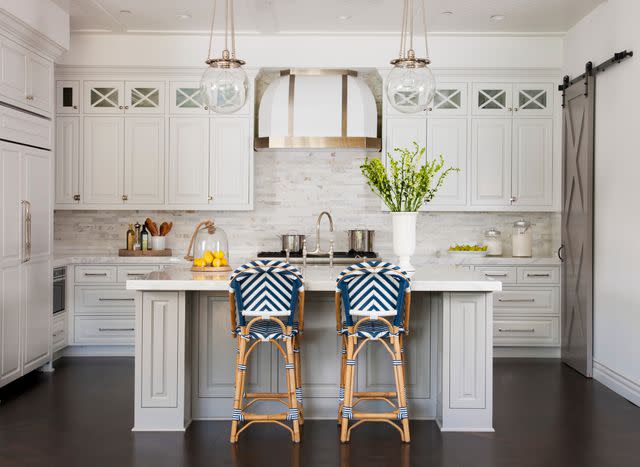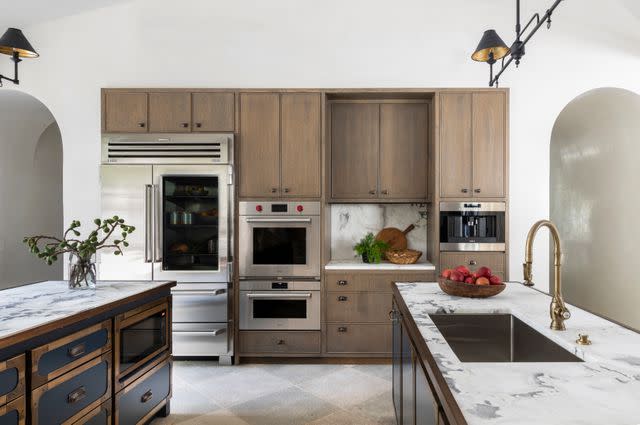What Are Inset Kitchen Cabinets?
Remodeling your kitchen or building a home? Cabinets are a big decision. Here are the pros and cons of inset cabinets.
After appliances, cabinets are the most critical aspect of a kitchen's design. Their aesthetic and functional variations can be challenging to select from, but they can make all the difference in enjoying your space.
These days, inset cabinets are a popular choice for many homeowners. Their timeless, elegant look isn't going out of style any time soon. Here's everything you need to know to decide if they are right for you.

ED GOHLICH
What Are Inset Kitchen Cabinets?
Inset cabinets are constructed with doors or drawers designed to fit flush inside their cabinet frame. This creates a unique, classy, and custom look because there are no protruding edges or corners. To open and close these cabinets, you need a door pull, handle, or knob, since there are no spaces or lips to grip your fingers. Design lovers will enjoy choosing hardware that pops against the color or wood grain of the cabinet.
Inset cabinets are typically available in two looks: flush or beaded. Flush frames have a standard industrial look, with square edges that flush into the cabinet's face. In contrast, beaded frames have a single border inside the cabinet openings. These create a more utilitarian and decorative look.
Wood is the most common material for making inset cabinets, although many people paint their cabinets a color rather than exposing the original wood grain.
The History Behind Inset Kitchen Cabinets
Inset cabinets date back centuries. They were popularized in Europe's Georgian and Victorian eras (18th and 19th centuries), when they were handmade by artisans. British carpenters carried the design aesthetic to America, and it has thrived in North America ever since. By the late 19th century, this cabinetry style became synonymous with simplicity and sophistication. This timeless look still offers versatility that modern families appreciate and enjoy.
Inset kitchen cabinets have pros and cons and are not suitable for every home. Homeowners in humid environments should look at other styles or be prepared for frequent maintenance.

JULIE SOEFER
Pros of Inset Kitchen Cabinets
Charm: Custom cabinets are a great way to showcase heritage style or to set the tone for a modern home. High-quality inset cabinets are bespoke. This modern look is a charming upsell for guests and future buyers, even in an older home.
Design flexibility: Unlike ultra-modern designs like hingeless cabinets, inset cabinets fit any design style, including historic, farmhouse, transitional, and modern homes. They are also available in multiple finishes, colors, and moldings. Inset cabinets are ideal for people looking for a middle ground between vintage looks and more trendy styles.
Space efficiency: Inset cabinets consume less exterior space. They are great for small kitchens and narrow galleys. Inset cabinets are the way to go when a few extra inches matter.
Related: Kitchen Cabinet Details That Wow
Cons of Inset Kitchen Cabinets
Custom crafting and installation: For proper installation of insets, you need to hire a professional who can hang the doors without gaps for a smooth appearance. This can spell time delays in crafting and installation.
Hardware matters: Since the cabinet is flat, you need a door pull or knob to open it. As a result, eye-popping hardware can become the most prominent feature of the cabinet. Fortunately, there are great finishes to choose from that leave a lasting positive impression.
Higher cost: Custom insets typically cost more than their traditional alternatives. For small kitchens, those costs might seem minimal. However, the price difference could be significant for large kitchens with upper and lower cabinets, islands, and other features.
Limited storage: Cabinets with inset doors have less storage space than different cabinet styles.
Maintenance: Inset cabinets are vulnerable to dimensional changes due to humidity. As the wood swells and contracts, inset doors and headers can bind and stop working. Homeowners must take care to reduce humidity and moisture accumulation. Also, inset cabinets come with a fair amount of cleaning burden to keep the sleek and flush look fingerprint-free.
Are Inset Cabinets Right for You?
Insets are elegant and timeless, so you really can't go wrong. Since the 18th century, they have added function, value, and character to kitchens. They're versatile and compatible with any home decor, so you'll never feel your cabinet style is outdated. With slight tweaks to the color and hardware, these cabinets can last a lifetime.
However, inset cabinets are not ideal for humid homes. Dehumidifying is essential to upkeep when the cabinets are installed in beach houses or homes in other humid climates. Regular maintenance may mean regular door or drawer adjustments to keep the drawers flush and functional.
Some of the heartburn can be avoided from the outset by choosing the right material for your home's environment and positioning and organizing the cabinets in a way that protects them from heat and light sources.
Because most inset cabinets are custom-made and installed, you'll want to consider these details early on to ensure you get the best value over time.
For more Better Homes & Gardens news, make sure to sign up for our newsletter!
Read the original article on Better Homes & Gardens.

